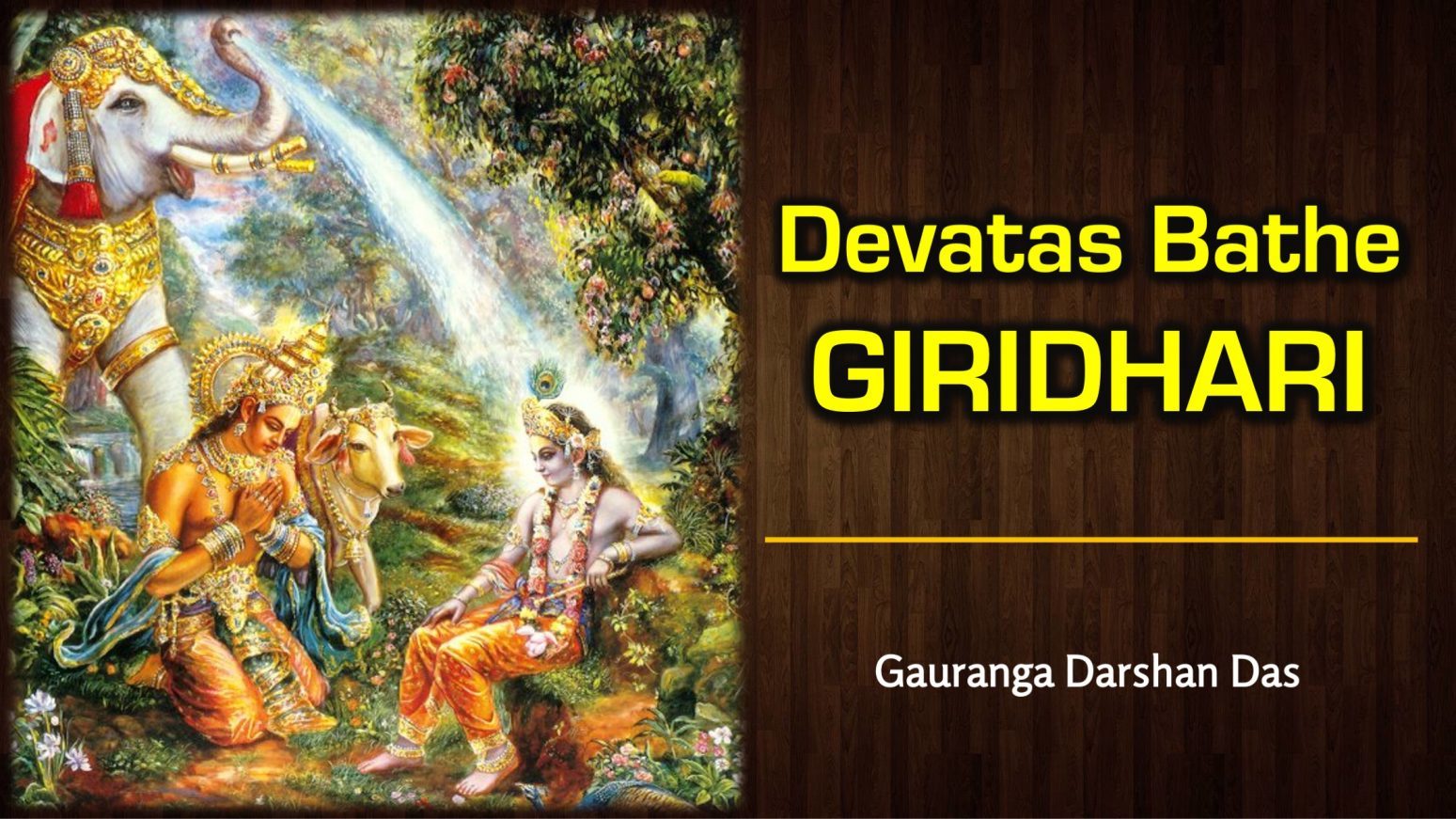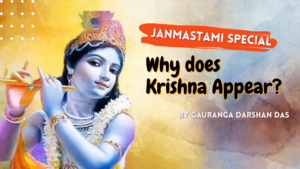Devatas Bathe Giridhari
by Gauranga Darshan Das
Holy scriptures glorify the Supreme Lord as atma-rama – self-satisfied, who does not need to seek happiness from anything beyond Himself. He is the source of everything that exists in the entire cosmic manifestation. Offering anything to Him may be compared to the offering of a small lamp to the Sun God who is the source of all heat and light. Yet the Supreme Lord accepts the minute presentations from His devotees offered with love and devotion, just as a father is delighted to accept a small gift offered by his child although it is not perfect. It is an expression of gratitude on the part of the worshiper to offer anything to the Lord. Worship of the Lord involves offering Him several sanctified paraphernalia. One such episode where the Lord receives worship from His dear devotees is recorded in the pages of Srimad Bhagavatam.
Krishna, whose face is as fresh as a blue lotus flower bathed in soft moonlight, crushed the false pride of Indra, the king of heavens, by lifting the Govardhan Mountain. To get relief from the fatigue of holding the mountain up for a week, Krishna strolled along a ridge of the Govardhan. Indra, who got down from the mountain of his false pride after receiving sufficient chastisement from the Lord, came in front of Him accompanied by Surabhi cow and begged forgiveness for his offense. After offering his choicest prayers unto the Lord, Indra, accompanied by Brahma, Siva, Uma, Saraswati, Vayu, Agni, Narada, Tumburu and many other exalted demigods and sages offered to perform the Abhisheka ceremony of the Lord. Krishna smiled attractively as His beautiful teeth sparkled like thousand rays of light and allowed them to worship Him.
For the bathing ceremony of the Lord, the Govardhan Mountain with the limbs of his own body provided an elegant throne for Krishna, made of smooth stone and jewels. Krishna’s white lotus flower expanded into many white umbrellas to shield the Lord. The goddess of Gandhamadana Mountain brought golden lotuses from Manasasarovara Lake and personally strung a garland for Krishna. The personified forms of sacred oceans, rivers, ponds and lakes came with pots of water to bathe Krishna. The goddess of the Malaya Mountain delivered the best quality sandalwood. Various mantras and prayers like Purusha-sukta and Sri-sukta took personal forms to chant. The Surabhi cow offered the pancha-gavya (milk from her udder, cow dung, cow urine, ghee and curd). Lord Brahma provided the pancha-amrita (milk, yogurt, ghee, sugar and honey). Airavata filled the gem-studded bathing pots with waters from Akasha-Ganga. With these ingredients and many more contributed by different exalted personalities, Lord Brahma worshiped Krishna starting with washing His feet, and offering Him delicious madhuparka and tambula. The captivating splendour of Krishna’s body during the abhisheka ceremony appeared like a monsoon cloud being bathed in moonshine, a small hill of blue-sapphires covered by pure water of celestial gems, or a blue lotus covered with bright white camphor.
After the Abhisheka, Krishna’s beautiful body is dried with fine soft cloths. The goddess of Mount Sumeru offered a golden cloth, and the goddess of Himalayas presented splendid necklaces. The Lord’s dress is gorgeous with the glimmering golden ornaments outshining the pollen of Kadamba flowers. The full moon assumed the form of a mirror made of jewels. After the bath and dressing, Brahma performed the Arati for Krishna. Pancajanya, the Lord’s celebrated conch shell, sanctified the atmosphere with loud sounds. Agni offered an artistically designed golden incense pot. The effulgent Sudarshana chakra expanded into as many lamps to illumine all directions. The Vanadevis supplied sweet-smelling forest flowers. Vayu, his arms trembling in ecstatic devotion, fanned the Lord with a chamara whisk. Bhumi devi delivered incredible natural scents. The rishis recited purifying hymns and the demigods played the appropriate melodies as the apsaras danced in euphoria. Finally, Brahma distributed maha-prasadam to all the devotees. Thus the Supreme Lord Sri Krishna is bathed and worshiped by His beloved devotees with all awe and reverence.
Such opportunity of worshiping the Lord is available for us also. As the Lord’s pure spiritual form cannot be seen by our material vision, the Lord mercifully manifests Himself in the form of Archa vigraha of eight varieties – stone, wood, metal, earth, paint, sand, the mind or jewels. This Archa form, installed in the temples by self-realized acharyas, is non-different from the original form of the Lord. The process of worshiping this Archa form is called archana and involves offering the Lord 16 items (shodashopachara): 1. Asana (sitting place), 2. Svagata (asking to sit), 3. Arghya (water), 4. Padya (water to wash legs), 5. Achamana (washing mouth), 6. Madhu-parka, 7. Punarachamana (washing mouth again), 8. Snana (Bath), 9. Vastra (Garments), 10. Alankara (decorating with ornaments), 11. Gandha (sweet scents), 12. Pushpa (fragrant flowers), 13. Dhupa (incense), 14. Deepa (lamp), 15. Naivedya (Food), 16. Pranama (prayers). All these items represent various material elements in their pure form and the corresponding sense objects (fire, touch, sound, form etc…). Among all the upacharas, bathing and decorating are most pleasing to Lord Krishna. And the most important ingredient in any offering is love for the Lord. One is relieved from all sinful reactions by regularly watching the lotus face of the Lord during the Arati. Deity worship automatically brings purity and satisfaction to the mind. By worshiping Lord Vishnu along with His wife, Laxmi, one achieves all opulences. By worshiping Lord Sri Hari with unconditional devotion in this manner, one gains access to pure loving service to His lotus feet.





Mesmerizing account of Giridhari by Shri Gauranga Darshan Das Feeling bathed in Transcendental bliss.
Gratitude.
Yhs